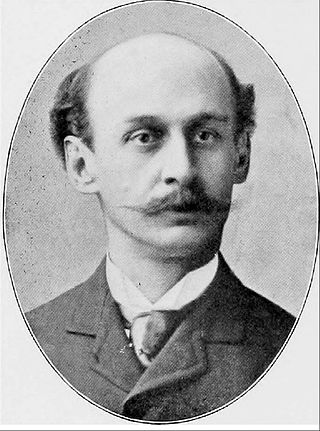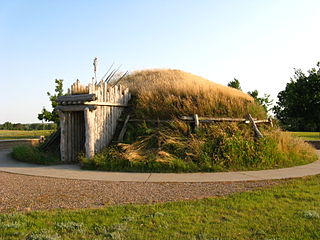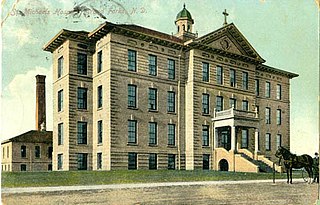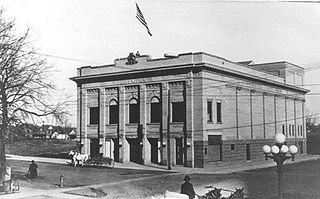
The Missouri River is a river in the Central and Mountain West regions of the United States. The nation's longest, it rises in the eastern Centennial Mountains of the Bitterroot Range of the Rocky Mountains of southwestern Montana, then flows east and south for 2,341 miles (3,767 km) before entering the Mississippi River north of St. Louis, Missouri. The river drains semi-arid watershed of more than 500,000 square miles (1,300,000 km2), which includes parts of ten U.S. states and two Canadian provinces. Although a tributary of the Mississippi, the Missouri River is slightly longer and carries a comparable volume of water. When combined with the lower Mississippi River, it forms the world's fourth-longest river system.

Yankton is a city in and the county seat of Yankton County, South Dakota, United States.

Jean Baptiste Charbonneau, sometimes known in childhood as Pompey or Little Pomp, was a Lemhi Shoshone-French Canadian explorer, guide, fur trapper, trader, military scout during the Mexican–American War, alcalde (mayor) of Mission San Luis Rey de Francia and a gold digger and hotel operator in Northern California. His mother was Sacagawea, a Shoshone who worked as a guide and interpreter for the Lewis and Clark Expedition. Charbonneau spoke French and English and learned German and Spanish during his six years in Europe from 1823 to 1829. He spoke Shoshone and other western Native American languages, which he picked up during his years of trapping and guiding.

Henry Janeway Hardenbergh was an American architect, best known for his hotels and apartment buildings, and as a "master of a new building form — the skyscraper." He worked three times with Edward Clark, the wealthy owner of the Singer Sewing Machine Company and real estate developer: The Singer company's first tower in New York City, the Dakota Apartments, and its precursor, the Van Corlear. He is best known for building apartment dwellings and luxury hotels.

Fort Mandan was the name of the encampment which the Lewis and Clark Expedition built for wintering over in 1804–1805. The encampment was located on the Missouri River approximately twelve miles (19 km) from the site of present-day Washburn, North Dakota, which developed later. The precise location is not known for certain. It is believed now to be under the water of the river. A replica of the fort has been constructed near the original site.

Fort Abraham Lincoln State Park is a North Dakota state park located 7 miles (11 km) south of Mandan, North Dakota, United States. The park is home to the replica Mandan On-A-Slant Indian Village and reconstructed military buildings including the Custer House.

The Knife River Indian Villages National Historic Site, which was established in 1974, preserves the historic and archaeological remnants of bands of Hidatsa, Northern Plains Indians, in North Dakota. This area was a major trading and agricultural area. Three villages were known to occupy the Knife area. In general, these three villages are known as Hidatsa villages. Broken down, the individual villages are Awatixa Xi'e, Awatixa and Big Hidatsa village. Awatixa Xi'e is believed to be the oldest village of the three. The Big Hidatsa village was established around 1600.
Kirtland Cutter was a 20th-century architect in the Pacific Northwest and California. He was born in East Rockport, Ohio, the great-grandson of Jared Potter Kirtland. He studied painting and illustration at the Art Students League of New York. At the age of 26 he moved to Spokane, Washington, and began working as a banker for his uncle. By the 1920s, Cutter had designed several hundred buildings that established Spokane as a place rivaling Seattle and Portland, Oregon in its architectural quality. Most of Cutter's work is listed in State and National Registers of Historic Places.

The Langham is a luxury apartment building located at 135 Central Park West on the Upper West Side of Manhattan, New York City. After the site was unused for more than 15 years, the building was constructed between 1905 and 1907. Built at a cost of US $2 million, the structure included modern amenities, such as an ice maker in every apartment. The building was designed in the French Second Empire style by architects Clinton and Russell. It was listed as a contributing property to the federal government designated Central Park West Historic District on November 9, 1982.

The Big Hidatsa site, occupied between ca. 1740 and 1850, is an earthlodge located in the 1,758 acre Knife River Indian Villages National Historic Site in North Dakota, United States. This National Historic Site was established in 1974 “to focus on the cultures and lifestyles of the Plains Indians”.

Sacagawea was a Lemhi Shoshone woman who, in her teens, helped the Lewis and Clark Expedition in achieving their chartered mission objectives by exploring the Louisiana Territory. Sacagawea traveled with the expedition thousands of miles from North Dakota to the Pacific Ocean, helping to establish cultural contacts with Native American people and contributing to the expedition's knowledge of natural history in different regions.

The Soo Hotel was later known as the Princess Hotel, The Patterson Hotel Annex, The Hotel Dakotan, Heritage Recovery Center, and Heritage Apartments. It is a historic building located on Fifth Street North in Bismarck, North Dakota, United States, and was listed on the National Register of Historic Places in 1983. It was built by prominent businessman and political powerhouse Edward Patterson in 1906 as a second-class hotel to his other property, the high-class Northwestern Hotel. The four-floor, 76-room hotel was named after the Soo Line Railroad which had arrived in town in 1902 and whose depot was located several blocks away. It was briefly the tallest building in Bismarck.

George Hancock was an architect active in North Dakota, Montana and Minnesota.

The Rudolf Hotel in Valley City, North Dakota is a three-story hotel building that was built in 1907. It was designed by John W. Ross in Classical Revival style. It was listed on the National Register of Historic Places in 1983.

Saints Peter and Paul Church is a Roman Catholic church in New Hradec, North Dakota. The church, which was built in 1917, was designed by Nick Ressler with elements of the Gothic Revival and Tudor Revival styles. The church has historically served a unique congregation of Czech immigrants from the Crimea and is considered to be the most significant representation of New Hradec's Czech heritage. It was listed on the National Register of Historic Places in 1986.

William F. Kurke (1889–1965) was a prolific architect in North Dakota.
The Stuart Dunlap House on 7th Ave. in Mandan, North Dakota was listed on the National Register of Historic Places in 1992.

Mandan Commercial Historic District is a 20-acre (8.1 ha) historic district in Mandan, North Dakota that has work dating to 1884. It was listed on the National Register of Historic Places (NRHP) in 1985. The listing includes 35 contributing buildings and a contributing object.

Arthur Wesley Van Horn was a prolific architect of Bismarck, North Dakota. A number of Van Horn's works, alone or as part of his firm, are listed on the U.S. National Register of Historic Places.
This timeline of South Dakota is a list of events in the history of South Dakota by year.






















